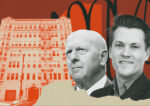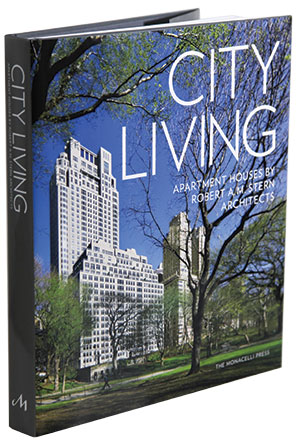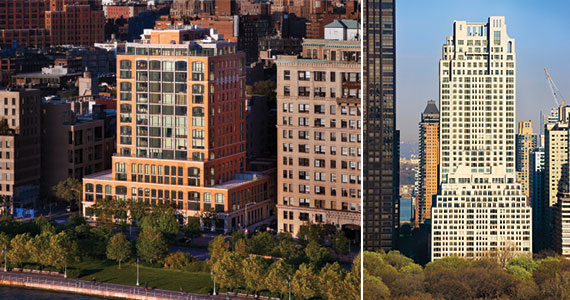Trending
 “Multifamily is in the crosshairs”: Execs talk distress, opportunities at Milken conference
“Multifamily is in the crosshairs”: Execs talk distress, opportunities at Milken conference "Financially devastating": Receiver takes over embattled Pembroke Pines condo complex
"Financially devastating": Receiver takes over embattled Pembroke Pines condo complex Goldman Sachs and Ballast ready to surrender SF apartments to lender
Goldman Sachs and Ballast ready to surrender SF apartments to lender Blackstone sells huge industrial portfolio in NYC, New Jersey
Blackstone sells huge industrial portfolio in NYC, New JerseyBook Review: The architectural eye candy of Robert A.M. Stern
Robert A.M. Stern’s latest coffee-table tome 'City Living' showcases a rare and first-rate body of work

By now, most New Yorkers with any interest in real estate or architecture have an intuitive sense of just how active Robert A. M. Stern Architects has been in the city over the past decade and a half. And there is no question that all of that activity has been to the great benefit of our skyline.
But it takes a book like “City Living,” sumptuously published in January by the Monacelli Press, to remind us of the variety and quality that characterize the firm’s work. This oversized 360-page tome runs through 15 projects completed by the firm as well as 16 more that are in the works, providing a brief discussion of each.
Of the completed projects, eight are in Manhattan and another three are almost done on the island. (And that number does not include other projects by the firm that were completed before the year 2000).
Although this volume functions primarily as a coffee-table book, with lavish and abundant photographs, it also includes excerpts from a lengthy discussion moderated by the architecture critic Paul Goldberger with Stern and his colleagues Paul Whalen, Daniel Lobitz and Michael Jones. Their shoptalk about creating iconic buildings in the Big Apple was great fun to read — and added some welcome and insightful substance to the visual delights of the book.
For example, Stern provides a window into his working relationship with some of the biggest developers in the city, including Vornado Realty Trust’s Steve Roth.

L to R: Michael D. Jones, Daniel Lobitz, Robert A.M. Stern, Paul Goldberger and Paul L. Whalen
“Oh my God! He comes here for regular two-hour meetings. It’s like his therapy! He’s totally involved. He worries about every detail,” said Stern, who designed Vornado’s ultra-luxurious condo development now under construction at 220 Central Park South.
Stern’s partners also make discerning observations.
Whalen explains how the design of 15 Central Park West — the game-changing condo that he and Jones served as lead architects on — brings together qualities usually distinctly seen on the Upper East Side or the Upper West Side.
“Upper West Side buildings, and in particular Central Park West buildings, incorporated great iconic towers that have a major impact on the New York skyline. In a way they’re a little showy,” he said. “Upper East Side buildings are much more restrained; they don’t have great towers on them unless they’re hotels and many of the tops, like for instance at 740 Park Avenue, step back in a picturesque way with setback terraces and gardens that create an irregular landscape.”
In addition to these observations, the firm’s partners have included short essays explaining the specifics of each building and the site.
And the book also sheds light on projects the firm has completed outside of New York. Among them are the rationalist Century in Los Angeles, the Ritz-Carlton in Dallas and the Heart of the Lake development, a 2-million-square-foot residential complex in the coastal city of Xiamen, China — not to mention other projects, still in progress, in places as varied as Moscow, Taipei and Lima, Peru.
Still, as interesting as the text is, the book’s main draw is the photos.
When it comes to New York, the images throughout the book show that — amid the generally drab and mediocre architectural fare that defines Manhattan — few local firms that have designed a good number of buildings in the borough have left a larger or more distinguished mark on the city than Robert A. M. Stern Architects. And while this may not sound like much, it is worth noting that the firm has never created a bad or ugly building, a building that has insulted the street or coarsened to some degree the lives of our fellow pedestrians. Few other local firms can claim as much.

400 West 12th Street and 15 Central Park West
Each building designed by this firm has improved the streetscape of Manhattan to some degree and elevated the neighborhood. This is true especially of the buildings conceived in self-conscious imitation of the traditional buildings of the Upper East and West Sides, like 15 Central Park West, with the pristine paleness of its limestone, or the soon-to-be-completed 30 Park Place, down by City Hall.
Similar qualities, though in a slightly more vernacular form, can be found at the Chatham, on Third Avenue and 65th Street, with its use of red brick and limestone accents, as well as at 18 Gramercy Park, in which the red brick predominates. What these projects share is a sense of architectural context, a constant of this firm’s practice.
That fidelity can also manifest itself in the shift to a more industrial, but equally historicist, vocabulary of form in a building like Abington House on the High Line, with its sturdy gray brick facade and detail, as well as the warehouse aesthetic of Superior Ink on West Street.
Much of this will already be well known to the average New Yorker who walks among these projects. But to see all of these projects massed together provides a new and greatly enhanced sense of this firm’s achievement.
James Gardner is TRD’s architecture critic and the author of the recently released book “Buenos Aires: The Biography of a City.”
